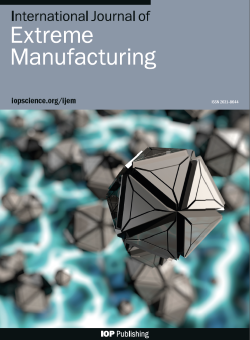用于成像光学的双光子聚合光刻技术
IF 16.1
1区 工程技术
Q1 ENGINEERING, MANUFACTURING
引用次数: 0
摘要
光学成像系统极大地扩展了人类的视觉能力,使人们能够观察和理解各种现象。成像技术的波长范围很广,从 X 射线到无线电频率,影响着研究活动和我们的日常生活。传统的玻璃透镜是通过一系列复杂的工艺制作而成,而聚合物透镜则具有多功能性且易于生产。然而,现代应用往往需要复杂的透镜组件,因此需要微型化和具有微米和纳米级特征的先进设计,以超越传统制造方法的能力。三维(3D)打印或增材制造为应对这些挑战提供了解决方案,具有快速原型制作、定制几何形状和高效生产等优点,尤其适用于微型化光学成像设备。与传统方法相比,各种三维打印方法已显示出优势,但在实现纳米级分辨率方面仍存在挑战。双光子聚合光刻(TPL)是一种纳米级三维打印技术,通过液态树脂中的双光子吸收非线性过程,可以制造出超越光学衍射极限的复杂结构。它具有前所未有的能力,例如无对准制造、微米级和纳米级能力,以及几乎任意复杂三维纳米结构的快速原型制造。在这篇综述中,我们强调了成像设备光学性能评估标准的重要性,讨论了与 TPL 相关的材料特性、制造技术,并重点介绍了 TPL 在光学成像中的应用。作为该主题的首篇全景式综述,它将为研究人员提供成像光学领域 TPL 的基础知识和最新进展,促进对该领域的深入了解。通过利用其高分辨率能力、广泛的材料范围和真正的三维加工,以及材料、制造和设计方面的进步,我们设想了应对当前挑战的颠覆性解决方案,以及将 TPL 融入未来光学成像应用的前景。本文章由计算机程序翻译,如有差异,请以英文原文为准。
Two-Photon Polymerization Lithography for Imaging Optics
Optical imaging systems have greatly extended human visual capabilities, enabling the observation and understanding of diverse phenomena. Imaging technologies span a broad spectrum of wavelengths from X-ray to radio frequencies and impact research activities and our daily lives. Traditional glass lenses are fabricated through a series of complex processes, while polymers offer versatility and ease of production. However, modern applications often require complex lens assemblies, driving the need for miniaturization and advanced designs with micro- and nanoscale features to surpass the capabilities of traditional fabrication methods. Three-dimensional (3D) printing, or additive manufacturing, presents a solution to these challenges with benefits of rapid prototyping, customized geometries, and efficient production, particularly suited for miniaturized optical imaging devices. Various 3D printing methods have demonstrated advantages over traditional counterparts, yet challenges remain in achieving nanoscale resolutions. Two-photon polymerization lithography (TPL), a nanoscale 3D printing technique, enables the fabrication of intricate structures beyond the optical diffraction limit via the nonlinear process of two-photon absorption within liquid resin. It offers unprecedented abilities, e.g., alignment-free fabrication, micro- and nanoscale capabilities, and rapid prototyping of almost arbitrary complex 3D nanostructures. In this review, we emphasize the importance of the criteria for optical performance evaluation of imaging devices, discuss material properties relevant to TPL, fabrication techniques, and highlight the application of TPL in optical imaging. As the first panoramic review on this topic, it will equip researchers with foundational knowledge and recent advancements of TPL for imaging optics, promoting a deeper understanding of the field. By leveraging on its high-resolution capability, extensive material range, and true 3D processing, alongside advances in materials, fabrication, and design, we envisage disruptive solutions to current challenges and a promising incorporation of TPL in future optical imaging applications.
求助全文
通过发布文献求助,成功后即可免费获取论文全文。
去求助
来源期刊

International Journal of Extreme Manufacturing
Engineering-Industrial and Manufacturing Engineering
CiteScore
17.70
自引率
6.10%
发文量
83
审稿时长
12 weeks
期刊介绍:
The International Journal of Extreme Manufacturing (IJEM) focuses on publishing original articles and reviews related to the science and technology of manufacturing functional devices and systems with extreme dimensions and/or extreme functionalities. The journal covers a wide range of topics, from fundamental science to cutting-edge technologies that push the boundaries of currently known theories, methods, scales, environments, and performance. Extreme manufacturing encompasses various aspects such as manufacturing with extremely high energy density, ultrahigh precision, extremely small spatial and temporal scales, extremely intensive fields, and giant systems with extreme complexity and several factors. It encompasses multiple disciplines, including machinery, materials, optics, physics, chemistry, mechanics, and mathematics. The journal is interested in theories, processes, metrology, characterization, equipment, conditions, and system integration in extreme manufacturing. Additionally, it covers materials, structures, and devices with extreme functionalities.
 求助内容:
求助内容: 应助结果提醒方式:
应助结果提醒方式:


